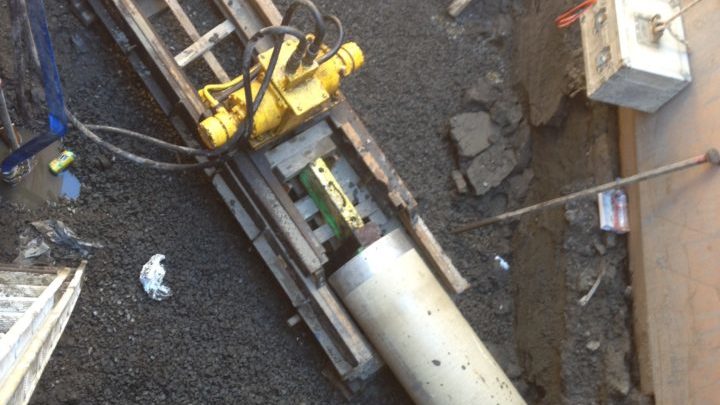Pipe jacking is a trenchless pipeline installation method that has gained popularity as an alternative to open cut methods in urban areas where existing infrastructure needs to be navigated and disruption to residents needs to be minimised. Here, we look at the environmental, urban and safety benefits of pipe jacking, and why it should be considered over other methods of pipeline installation.
What is pipe jacking?
Pipe jacking is a non-disruptive method of installing pipes where the pipe is directly installed in a continuous length behind a machine while controlled excavation takes place at the face. The result is a flexible, structural, watertight finished pipeline.
Using this method, pipes manufactured from a variety of materials — including concrete, clay, GRP, steel and ductile — and diameters can be installed. The length of the individual pipe jack is determined through practical engineering consideration, including ground conditions, as well as budget restrictions.
Pipe jacking is used in projects where obstacles such as roads, railways, rivers and buildings need to be negotiated to minimise the amount of surface disruption in urban areas that is associated with open cut methods of installation.
Environmental benefits
There are a number of environmental problems associated with traditional open cut methods that pipe jacking eliminates.
“One of the key environmental benefits of pipe jacking is a reduced site footprint. Open cut methods require trenches to be dug along the length of the pipeline installation, resulting in greater ground disruption and higher restoration costs,” Stuart Harrison, Managing Director at Edge Underground said.
“Unlike open cut methods, pipe jacking only requires the excavation of an entry and exit pit, with the ground between these points left undisturbed.
“As there is less ground disturbance, there is less impact to the surrounding environment, flora and fauna. The installation will also be quicker to complete and restoration costs are reduced.”
When using appropriate machinery, further environmental benefits can be found in a reduction of carbon emissions.
The Vermeer AXIS guided boring system has been proven to have low carbon emissions.
An emission study on the AXIS system was conducted in the US by Dr Sam Ariaratnam and his team at Arizona State University. The study utilised the ‘E Calc’ emissions calculator and the results were compared with alternative methods, with the AXIS system conclusively presenting the least emissions of the methods.
Urban benefits
As pipe jacking has a limited site footprint, there is also less disruption to residents and businesses around the construction site, and projects can be undertaken where pipe needs to be installed under infrastructure such as roads and railways.
“Open cut methods can be very disruptive to the community, as the length of the installation — which may include roads and footpaths — needs to be blocked off for long periods of time as the ground is excavated and restored, and to ensure public safety,” Mr Harrison said.
“There are also problems for other trenchless installation techniques in urban areas. For instance, horizontal directional drilling (HDD) can be difficult in residential areas.
“Unlike pipe jacking which is a shaft to shaft installation technique, HDD is surface launched so the machine needs to sit back from the starting point. A continuous length of pipe also needs to be used, so on the exit point there needs to be enough room to have it laid out. This means it won’t be suitable for projects where the machine or pipe will need to be placed on private property.”
There are further benefits if the equipment used is modular.
Equipment like the Vermeer AXIS can be configured in a number of ways for jobsite footprint and transport considerations to accommodate customer preference and minimise traffic disturbance.
Safety benefits
Pipe jacking is also a safer form of pipeline installation than open cut methods. According to Safe Work Australia, excavation work is considered dangerous as excavation failures can occur quickly, limiting the ability of workers to escape if a collapse were to occur. Furthermore, any construction work that is carried out in or near shafts or trenches is considered high risk. These risks increase the deeper the shaft or trench is, with depths greater than 1.5m considered high risk.
While there are still safety risks associated with pipe jacking as excavation of shafts is required, the extent of excavation is less and site supervision is contained to smaller areas, reducing the risk of public interface.
As less excavation is required, there is also a reduction in manhours, so the incidence of accidents are less.
Further safety benefits can be found for operators when using the AXIS system.
“The AXIS system has been designed with the safety of operators in mind, and has a level of safety that no other equipment on the market can offer,” Mr Harrison said.
“The operator is fully protected from their surrounding environment as they sit within a Falling Object Protective System (FOPS) safety enclosure for the duration of the installation. There is no need for them to be exposed to the outside environment and they are protected from above if anything should happen to fall into the pit.
“There are also unique safety mechanisms to help personnel while completing the installation, with pressure gauges including a vacuum gauge at the rear of the machine. These feed information to the operator, notifying them of changes in ground pressure, which could signify a trench that potentially contains live wires.
“In the case that live wires are hit, an in-built strike alert mechanism will sound, notifying the operator that the machine has become live, so the operator knows to remain safely within the machine until the power source has been deactivated.”

